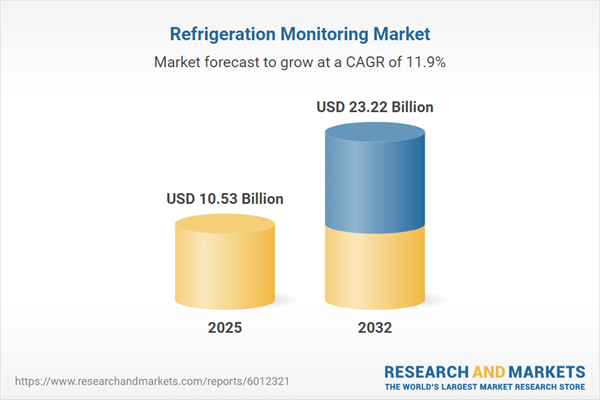Speak directly to the analyst to clarify any post sales queries you may have.
As global regulations evolve and digital transformation accelerates, refrigeration monitoring has become a priority for senior leaders seeking operational visibility and compliance. Modern monitoring solutions are now integral to resilient cold chains, offering the technical agility and transparent oversight required in today’s supply chain environments.
Market Snapshot: Refrigeration Monitoring Market Growth and Outlook
The global refrigeration monitoring market is experiencing steady growth, propelled by targeted enterprise investments in advanced digital solutions. Organizations are deploying IoT devices, sophisticated sensors, and real-time analytics platforms to streamline cold chain operations and achieve compliance. Expansion in this sector is especially notable in regions with strong regulatory frameworks, such as North America and Europe, while Asia-Pacific and Latin America drive adoption of modular monitoring systems tailored to dynamic local markets. Senior decision-makers are embedding flexible monitoring architectures to control operational risks, upgrade infrastructure, and sustain compliance. Ongoing product innovation sustains forward momentum, as businesses recognize the value of robust temperature and condition monitoring for high-value, sensitive goods.
Scope & Segmentation of Refrigeration Monitoring Solutions
- Component: Solutions integrate communication modules, sensors, controllers, software platforms, and power supplies, built for compliance and risk management across industries such as healthcare, food logistics, and warehousing.
- Monitoring Type: Systems address temperature, CO2 levels, humidity, pressure differentials, and door status, supporting adherence to quality and regulatory thresholds.
- Connectivity Type: Platforms utilize cellular, wired, Bluetooth, LoRaWAN, Wi-Fi, and Zigbee protocols, enhancing integration across centralized and distributed operations for continuous monitoring.
- Application: Core use cases include blast freezing, walk-in coolers, food processing, pharmaceutical storage, logistics, retail, and third-party logistics, each requiring tailored system controls and precise monitoring.
- Deployment Mode: Options span cloud-based (public, private, hybrid) and on-premises deployments, selected for optimal security, data access, and business continuity.
- Geographic Region: Implementation is shaped by local regulations, with North America and Europe focusing on established compliance, and other regions emphasizing adaptability and flexible rollouts as standards evolve.
- Key Companies: Industry leaders such as Emerson Electric Co., Johnson Controls International plc, Schneider Electric SE, Honeywell International Inc., Carrier Global Corporation, Siemens AG, Danfoss A/S, ABB Ltd, Azbil Corporation, and Fuji Electric Co., Ltd deliver solutions meeting the unique needs of compliance-driven sectors.
Key Takeaways: Strategic Insights for Senior Decision-Makers
- Deploying integrated analytics enables real-time visibility and prompt corrective action, advancing risk management throughout cold chain operations.
- IoT-enabled compliance automation minimizes manual checks and enables rapid adaptation to regulatory shifts, strengthening global supply chain responsiveness.
- Standardized hardware with open architectures supports seamless integration, system expansion, and efficient lifecycle management.
- High-resolution sensor data provides precise control of storage and transport conditions, helping protect sensitive inventories and maintain quality standards.
- Cloud-driven monitoring facilitates centralized coordination and unified oversight, supporting policy enforcement across multiple sites.
- Advanced reporting and cost management tools improve operational efficiency, equipping businesses to meet new regulatory and market challenges.
Tariff Impact: Navigating Supply Chain and Sourcing in 2025
Anticipated US tariffs are expected to increase costs for essential components such as sensors and communications hardware in the refrigeration monitoring market. Procurement teams are adopting supplier diversification and regional sourcing strategies to mitigate risks caused by market volatility. Consolidating orders and adjusting inventory practices further secure supply chains, ensuring operational stability in the face of continued external uncertainty.
Methodology & Data Sources
This refrigeration monitoring market report is founded on direct interviews with manufacturers, systems integrators, and subject-matter experts. Additional benchmarking data and industry disclosures provide comprehensive and credible insights, tailored for strategic executive decision-making in B2B markets.
Why This Refrigeration Monitoring Report Matters
- Empowers decision-makers to align investments with regulatory and sustainability imperatives, supporting sustained operational performance in refrigeration monitoring.
- Delivers actionable procurement and supply chain strategies to manage risk from tariffs and sourcing disruptions.
- Supports leadership in navigating complexity, boosting resilience, and adapting as technology and compliance standards evolve across global cold chains.
Conclusion
This report equips executives with the actionable intelligence needed to improve cold chain efficiency, strengthen reliability, and maintain compliance in refrigeration monitoring operations amid dynamic market change.
Additional Product Information:
- Purchase of this report includes 1 year online access with quarterly updates.
- This report can be updated on request. Please contact our Customer Experience team using the Ask a Question widget on our website.
Table of Contents
3. Executive Summary
4. Market Overview
7. Cumulative Impact of Artificial Intelligence 2025
List of Figures
Companies Mentioned
The companies profiled in this Refrigeration Monitoring market report include:- Emerson Electric Co.
- Johnson Controls International PLC
- Schneider Electric SE
- Honeywell International Inc.
- Carrier Global Corporation
- Siemens AG
- Danfoss A/S
- ABB Ltd
- Azbil Corporation
- Fuji Electric Co., Ltd.
Table Information
| Report Attribute | Details |
|---|---|
| No. of Pages | 185 |
| Published | November 2025 |
| Forecast Period | 2025 - 2032 |
| Estimated Market Value ( USD | $ 10.53 Billion |
| Forecasted Market Value ( USD | $ 23.22 Billion |
| Compound Annual Growth Rate | 11.9% |
| Regions Covered | Global |
| No. of Companies Mentioned | 11 |









